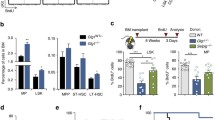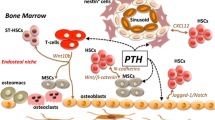Abstract
During mammalian ontogeny, haematopoietic stem cells (HSCs) translocate from the fetal liver to the bone marrow, where haematopoiesis occurs throughout adulthood1. Unique features of bone that contribute to a microenvironmental niche for stem cells might include the known high concentration of calcium ions at the HSC-enriched endosteal surface. Cells respond to extracellular ionic calcium concentrations through the seven-transmembrane-spanning calcium-sensing receptor (CaR), which we identified as being expressed on HSCs. Here we show that, through the CaR, the simple ionic mineral content of the niche may dictate the preferential localization of adult mammalian haematopoiesis in bone. Antenatal mice deficient in CaR had primitive haematopoietic cells in the circulation and spleen, whereas few were found in bone marrow. CaR-/- HSCs from fetal liver were normal in number, in proliferative and differentiative function, and in migration and homing to the bone marrow. Yet they were highly defective in localizing anatomically to the endosteal niche, behaviour that correlated with defective adhesion to the extracellular matrix protein, collagen I. CaR has a function in retaining HSCs in close physical proximity to the endosteal surface and the regulatory niche components associated with it.




Similar content being viewed by others
References
Tavassoli, M. Embryonic and fetal hemopoiesis: an overview. Blood Cells 17, 269–281 (1991)
Lord, B. I., Testa, N. G. & Hendry, J. H. The relative spatial distributions of CFUs and CFUc in the normal mouse femur. Blood 46, 65–72 (1975)
Gong, J. K. Endosteal marrow: a rich source of hematopoietic stem cells. Science 199, 1443–1445 (1978)
Nilsson, S. K., Johnston, H. M. & Coverdale, J. A. Spatial localization of transplanted hemopoietic stem cells: inferences for the localization of stem cell niches. Blood 97, 2293–2299 (2001)
Zhou, H. et al. Marrow development and its relationship to bone formation in vivo: a histological study using an implantable titanium device in rabbits. Bone 17, 407–415 (1995)
Deguchi, K. et al. Excessive extramedullary hematopoiesis in Cbfa1-deficient mice with a congenital lack of bone marrow. Biochem. Biophys. Res. Commun. 255, 352–359 (1999)
Jacenko, O. et al. Linking hematopoiesis to endochondral skeletogenesis through analysis of mice transgenic for collagen X. Am. J. Pathol. 160, 2019–2034 (2002)
Calvi, L. M. et al. Osteoblastic cells regulate the haematopoietic stem cell niche. Nature 425, 841–846 (2003)
Zhang, J. et al. Identification of the haematopoietic stem cell niche and control of the niche size. Nature 415, 836–841 (2003)
Silver, I. A., Murrills, R. J. & Etherington, D. J. Microelectrode studies on the acid microenvironment beneath adherent macrophages and osteoclasts. Exp. Cell Res. 175, 266–276 (1988)
Chattopadhyay, N., Vassilev, P. M. & Brown, E. M. Calcium-sensing receptor: roles in and beyond systemic calcium homeostasis. Biol. Chem. 378, 759–768 (1997)
House, M. G. et al. Expression of an extracellular calcium-sensing receptor in human and mouse bone marrow cells. J. Bone Miner. Res. 12, 1959–1970 (1997)
Olszak, I. T. et al. Extracellular calcium elicits a chemokinetic response from monocytes in vitro and in vivo. J. Clin. Invest. 105, 1299–1305 (2000)
Ho, C. et al. A mouse model of human familial hypocalciuric hypercalcemia and neonatal severe hyperparathyroidism. Nature Genet. 11, 389–394 (1995)
Garner, S. C., Pi, M., Tu, Q. & Quarles, L. D. Rickets in cation-sensing receptor-deficient mice: an unexpected skeletal phenotype. Endocrinology 142, 3996–4005 (2001)
Sutherland, H. J., Lansdorp, P. M., Henkelman, D., Eaves, A. C. & Eaves, C. J. Functional characterization of individual human hematopoietic stem cells cultured at limiting dilution on supportive marrow stromal layers. Proc. Natl Acad. Sci. USA 87, 3584–3588 (1990)
Yuan, Y., Shen, H., Franklin, D. S., Scadden, D. T. & Cheng, T. In vivo self-renewing divisions of haematopoietic stem cells are increased in the absence of the early G1-phase inhibitor, p18INK4C. Nature Cell Biol. 6, 436–442 (2004)
Cheng, T. et al. Hematopoietic stem cell quiescence maintained by p21cip1/waf1. Science 287, 1804–1808 (2000)
Cheng, T., Rodrigues, N., Dombkowski, D., Stier, S. & Scadden, D. T. Stem cell repopulation efficiency but not pool size is governed by p27kip1. Nature Med. 6, 1235–1240 (2000)
Orschell-Traycoff, C. M. et al. Homing and engraftment potential of Sca-1+lin- cells fractionated on the basis of adhesion molecule expression and position in cell cycle. Blood 96, 1380–1387 (2000)
Wolf, N. S. Dissecting the hematopoietic microenvironment. I. Stem cell lodgment and commitment, and the proliferation and differentiation of erythropoietic descendants in the Sl/Sld mouse. Cell Tissue Kinet. 7, 89–98 (1974)
Nilsson, S. K. et al. Immunofluorescence charaterization of key extracellular matrix proteins in murine bone marrow in situ. J. Histochem. Cytochem. 46, 371–377 (1998)
Kawai, M. et al. Development of hemopoietic bone marrow within the ectopic bone induced by bone morphogenetic protein. Blood Cells 20, 191–199 (1994)
An, J., Rosen, V., Cox, K., Beauchemin, N. & Sullivan, A. K. Recombinant human bone morphogenetic protein-2 induces a hematopoietic microenvironment in the rat that supports the growth of stem cells. Exp. Hematol. 24, 768–775 (1996)
Stier, S., Cheng, T., Dombkowski, D., Carlesso, N. & Scadden, D. T. Notch1 activation increases hematopoietic stem cell self-renewal in vivo and favors lymphoid over myeloid lineage outcome. Blood 99, 2369–2378 (2002)
Acknowledgements
We thank C. Seidman and J. Seidman for access to CaR-/- mice. Financial support for this work was provided by the American Society of Hematology (G.B.A.), the Burroughs Wellcome Fund, the Doris Duke Charitable Trust (D.T.S.) and the National Institutes of Health (M.R.P., E.B. and D.T.S.).
Author information
Authors and Affiliations
Corresponding author
Ethics declarations
Competing interests
Reprints and permissions information is available at npg.nature.com/reprintsandpermissions. The authors declare no competing financial interests.
Supplementary information
Supplementary Figure 1
Quantitative PCR analysis of car expression. RNA was obtained from purified CD11b+, CD3+ and lin-c-Kit+Sca-1+ (KLS) or lin-c-Kit+ (KL) cells and cDNA was made. Expression of car was then determined by real time PCR. Expression levels of car are shown relative to the expression of hprt. (PDF 11 kb)
Supplementary Figure 2
Cell cycle analysis of primitive bone marrow cells from mice transplanted with CaR+/+ or CaR-/- cells. Mononuclear cells from E17.5 fetal liver were transplanted into lethally irradiated wild-type hosts. Eight weeks following injection of the cells, the bone marrow was analyzed for cell cycle status. (PDF 16 kb)
Rights and permissions
About this article
Cite this article
Adams, G., Chabner, K., Alley, I. et al. Stem cell engraftment at the endosteal niche is specified by the calcium-sensing receptor. Nature 439, 599–603 (2006). https://doi.org/10.1038/nature04247
Received:
Accepted:
Published:
Issue Date:
DOI: https://doi.org/10.1038/nature04247
- Springer Nature Limited
This article is cited by
-
The roles of bone remodeling in normal hematopoiesis and age-related hematological malignancies
Bone Research (2023)
-
Distinct and targetable role of calcium-sensing receptor in leukaemia
Nature Communications (2023)
-
E3 ubiquitin ligase on the biological properties of hematopoietic stem cell
Journal of Molecular Medicine (2023)
-
Angelica sinensis polysaccharides prevents hematopoietic regression in D-Galactose-Induced aging model via attenuation of oxidative stress in hematopoietic microenvironment
Molecular Biology Reports (2023)
-
Nanotechnology in stem cell research and therapy
Journal of Nanoparticle Research (2023)





